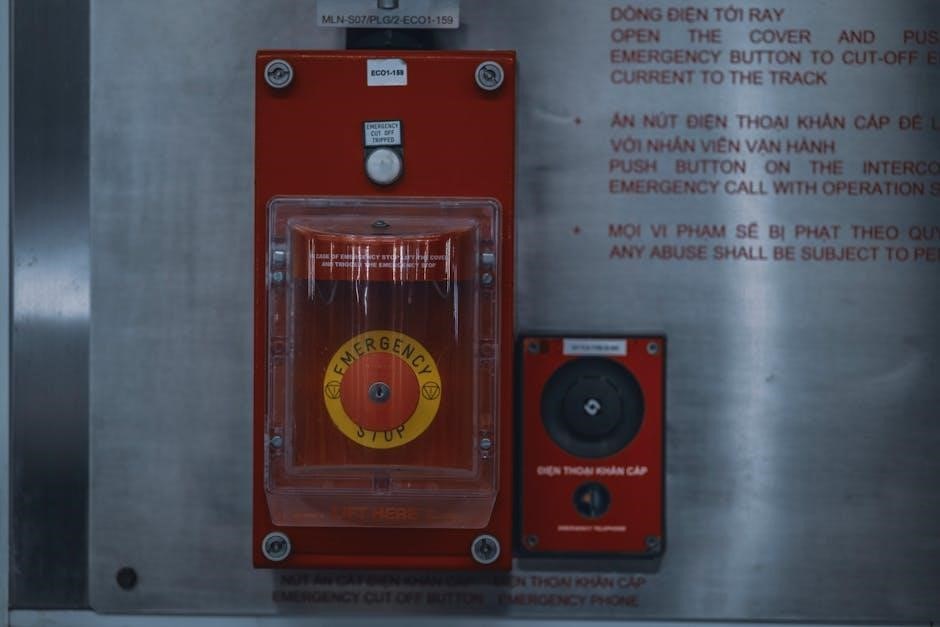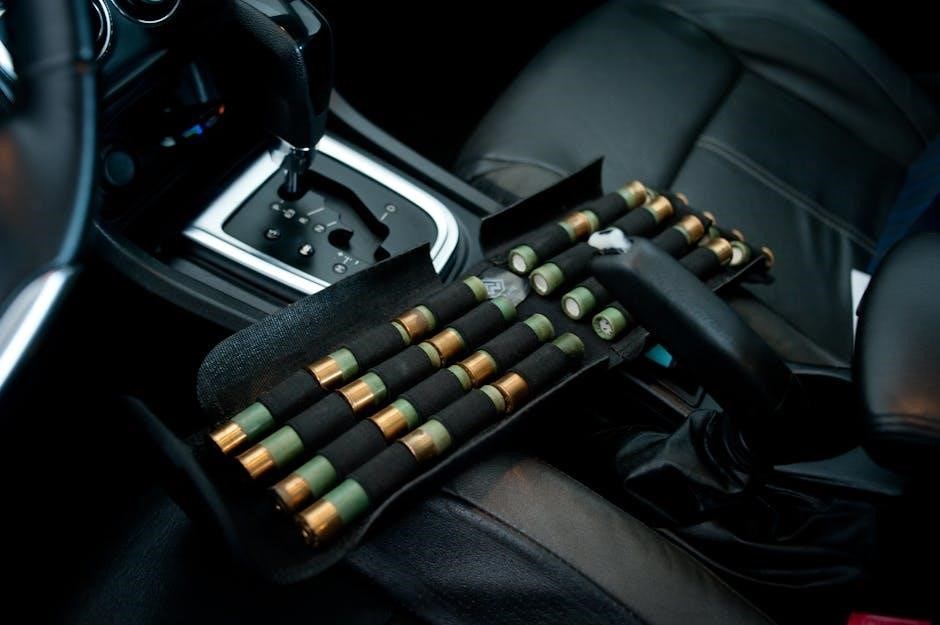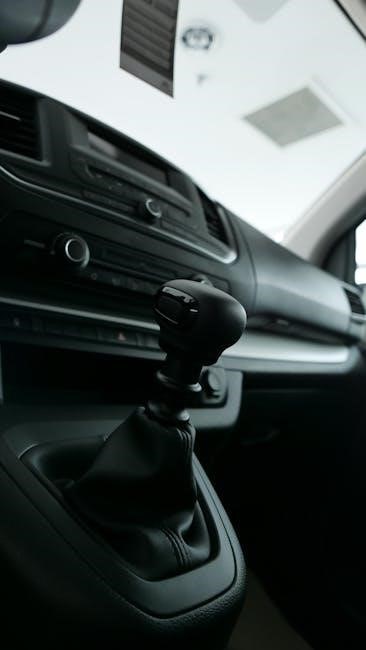emergency brake manual transmission
Emergency Brake in Manual Transmissions: A Comprehensive Guide
This guide explores the emergency brake’s vital role in manual transmission vehicles. It covers proper usage, maintenance, and dispels common myths. Mastering its use ensures safer driving and prevents transmission strain, especially on inclines. It is important to use it!
Understanding the Emergency Brake (Parking Brake)
The emergency brake, also known as the parking brake or e-brake, is a crucial safety component in vehicles, especially those with manual transmissions. It’s a secondary braking system, independent of the primary hydraulic brakes, designed to hold the vehicle stationary. Often engaged via a hand lever or foot pedal, it mechanically applies the rear brakes.
Many drivers mistakenly believe it’s solely for emergencies or hill parking. However, consistent use minimizes strain on the transmission and parking pawl, preventing premature wear. For manual cars, it’s essential for preventing rollaways, especially on inclines. Automatic transmission drivers might neglect it, but its regular use is beneficial.
It’s important to understand the parking brake’s function: providing a stronger hold than simply placing the car in “Park.” Understanding its mechanics and practicing its proper engagement and release is key to safe driving habits. Neglecting it can lead to unnecessary stress on vehicle components, increasing the risk of damage over time. Therefore, drivers should familiarize themselves with its operation.
Why Use the Emergency Brake with a Manual Transmission?
Using the emergency brake in a manual transmission vehicle is paramount for safety and vehicle longevity. Unlike automatic transmissions with a “Park” mode that locks the transmission, manual cars rely on gear engagement and the emergency brake to remain stationary. Without it, the car can roll, especially on inclines, posing a significant safety risk.
Engaging the emergency brake prevents strain on the transmission. Leaving the car solely in gear puts pressure on the gearbox and drivetrain components. The brake provides a dedicated holding force, reducing the risk of damage, especially if the car is bumped or nudged while parked. It acts as a fail-safe, preventing unexpected movement.
Moreover, using the emergency brake cultivates good driving habits. It becomes second nature, ensuring the car is secure in any situation. It’s a proactive measure, safeguarding against potential accidents. Regularly using the emergency brake ensures its functionality when truly needed. Neglecting it can lead to cable stretching or seizing, rendering it ineffective in emergencies. Therefore, consistent use is essential for both safety and maintenance.
Engaging the Emergency Brake: Step-by-Step
Properly engaging the emergency brake in a manual transmission car is crucial for safety. First, come to a complete stop using the primary brake pedal. Ensure the car is on a relatively level surface, if possible. Depress the clutch pedal and shift the transmission into first gear if facing uphill or reverse if facing downhill. This provides an additional layer of security against rolling.
Next, firmly apply the emergency brake. The method varies depending on the car. Some have a hand lever between the seats, while others use a foot pedal. For a hand lever, pull it upwards with a firm, consistent motion until you feel resistance. For a foot pedal, press it down fully until it locks into place. Avoid jerky or abrupt movements, as this can damage the brake cables.
Once engaged, release the primary brake pedal and observe if the car remains stationary. If it rolls slightly, re-engage the emergency brake more firmly. Finally, turn off the engine and remove the key. Before exiting the vehicle, double-check that the emergency brake is holding the car securely. This simple process ensures your car stays put, preventing accidents and damage.
Releasing the Emergency Brake: A Simple Process
Releasing the emergency brake in a manual transmission vehicle is a straightforward process, but it’s essential to do it correctly to avoid any sudden movements or damage to the braking system. Before releasing, ensure the engine is running and you’re prepared to drive. Depress the clutch pedal fully and shift the transmission into first gear if on level ground or facing uphill, or into reverse if facing downhill. This gives you control when the brake is disengaged.
To release a hand-lever type emergency brake, locate the release button, usually on the end of the lever. Press and hold this button while simultaneously lowering the lever to its disengaged position. For a foot-pedal type, press the pedal again slightly, which should release the locking mechanism, allowing the pedal to return to its resting position. Do this smoothly and deliberately.
After releasing the emergency brake, gently apply the gas pedal while slowly releasing the clutch to begin moving. Check the instrument panel to ensure the brake warning light is off, indicating complete disengagement. If the light remains on, double-check that the brake is fully released. A properly released emergency brake ensures smooth acceleration and prevents unnecessary wear on the braking system.
Emergency Stopping: Using the Emergency Brake as a Last Resort

In dire emergencies where the primary braking system fails in a manual transmission vehicle, the emergency brake can serve as a last resort, but its application requires caution. The most important rule for emergency or panic braking is not to touch the clutch unless the car is about to stall. Maintain focus on steering and road conditions. Gradually engage the emergency brake, applying steady, even pressure. Avoid jerking the lever or stomping on the pedal, as this can cause the wheels to lock up, potentially leading to a loss of control, especially on slick surfaces.
Be prepared for a longer stopping distance compared to the primary brakes. If the vehicle begins to skid, ease off the emergency brake slightly to regain control. Once stability is restored, reapply the brake gradually. Remember, the emergency brake is designed for holding, not stopping, and its effectiveness is significantly reduced at higher speeds. After bringing the vehicle to a stop, engage the hazard lights to warn other drivers and assess the situation. Consult a mechanic immediately to diagnose and repair the primary braking system before driving again.
Hill Starts: The Emergency Brake as an Aid
Hill starts in a manual transmission vehicle can be challenging, requiring coordination of the clutch, accelerator, and brake. The emergency brake becomes a valuable aid, preventing the car from rolling backward while transitioning from brake to accelerator. To execute a smooth hill start, engage the emergency brake firmly. Shift into first gear and gently apply pressure to the accelerator until the engine reaches the appropriate RPMs.

Gradually release the clutch, finding the friction point where the engine begins to engage. Simultaneously, slowly release the emergency brake while increasing pressure on the accelerator. The goal is to create a seamless transition, preventing any backward movement. Practice this technique in a safe, controlled environment to develop muscle memory and coordination. Some modern manual transmission vehicles feature hill-start assist, which automatically holds the brakes for a brief period, providing extra time for the driver to engage the clutch and accelerator. However, mastering the emergency brake technique remains a valuable skill for all manual transmission drivers, ensuring confident and controlled hill starts in any situation.
Automatic Emergency Braking (AEB) and Manual Transmissions

Automatic Emergency Braking (AEB) is a safety system designed to mitigate or prevent collisions by automatically applying the brakes when a potential crash is detected. While AEB systems are becoming increasingly common in modern vehicles, their integration with manual transmissions presents unique challenges. AEB systems typically rely on sensors to detect obstacles and calculate collision risk. In automatic transmissions, the system can seamlessly override the driver and apply the brakes. However, in manual transmissions, the driver’s engagement with the clutch introduces complexity.
Some automakers are hesitant to pair AEB with manual transmissions due to concerns about engine stalling during emergency braking. If the driver fails to depress the clutch, the AEB system could cause the engine to stall, potentially reducing braking effectiveness and control. Despite these challenges, some manufacturers are developing AEB systems specifically tailored for manual transmissions. These systems may incorporate features such as clutch override or stall prevention mechanisms. The integration of AEB with manual transmissions represents a significant step forward in enhancing safety for drivers of manual vehicles. As technology advances, more sophisticated AEB systems are likely to become available, further bridging the safety gap between manual and automatic transmissions.
Types of Emergency Brake Systems
Emergency brake systems, also known as parking brake systems, come in various designs, each with its own mechanism for engaging and applying braking force. The most common types include:
Lever-Type: Typically located between the front seats, this system utilizes a hand-operated lever connected to the rear brakes via cables. Pulling the lever tightens the cables, applying the brakes.
Pedal-Type: Found to the left of the foot pedals, this system engages the emergency brake when pressed. Releasing it often involves a separate release mechanism.
Electric Parking Brake (EPB): Newer vehicles often feature EPB systems, which use an electronic switch to activate motors that apply the brakes. EPB systems offer convenience and can integrate with other safety features.
Integrated Transmission Brake: Some systems, primarily in industrial applications, use a transmission brake, employing a dog clutch or pawl system for a positive lock. These are not intended for use while moving.
The choice of emergency brake system depends on vehicle design, cost considerations, and manufacturer preferences. Regardless of the type, regular maintenance and inspection are crucial to ensure proper functionality and safety.
Maintenance and Inspection of the Emergency Brake
Regular maintenance and inspection of your emergency brake are crucial for ensuring its reliability and effectiveness. Neglecting this vital component can lead to unexpected failures and compromise safety, especially in emergency situations or when parking on inclines.
Cable Inspection: Check the emergency brake cables for signs of wear, fraying, corrosion, or damage. Replace any damaged cables immediately, as they can snap or lose their ability to properly engage the brakes.
Lever/Pedal Mechanism: Inspect the lever or pedal mechanism for smooth operation. Ensure there is no excessive play or stiffness. Lubricate moving parts as needed.
Brake Shoe/Pad Inspection: Depending on the system, inspect the brake shoes or pads for wear and tear. Replace them if they are worn down to the minimum thickness.
Adjustment: Periodically adjust the emergency brake to ensure proper engagement. Over time, cables can stretch, requiring adjustment to maintain optimal performance.
Testing: Regularly test the emergency brake by engaging it while parked on a slight incline. The vehicle should remain securely in place.
Consult your vehicle’s owner’s manual for specific maintenance recommendations and schedules. If you are not comfortable performing these tasks yourself, seek the assistance of a qualified mechanic.
Common Misconceptions About Emergency Brakes
Several misconceptions surround the emergency brake, leading to misuse or neglect. One common myth is that it’s only necessary on hills or with manual transmissions. However, regular use prevents cable seizing and ensures functionality when needed, regardless of the terrain or transmission type.
Another misconception is that it’s solely for emergencies. While it can stop a car with failed brakes, its primary role is as a parking brake. Relying solely on “Park” in automatics puts strain on the transmission’s parking pawl, potentially causing damage over time.
Some believe using the emergency brake stretches the cables. While cables can stretch with age, regular use doesn’t accelerate this. Infrequent use is more detrimental, causing corrosion and stiffness.
Another myth is that it’s unnecessary in modern cars with robust transmissions. However, the emergency brake provides an independent mechanical system, offering an extra layer of security against rollaway, especially on uneven surfaces.
Finally, some believe it’s acceptable to use the emergency brake to perform an emergency stop in slick conditions. This is dangerous and can cause loss of control.

The Emergency Brake vs. Transmission Park Pawl
Understanding the difference between the emergency brake and the transmission park pawl is crucial for vehicle safety and longevity. The park pawl, found in automatic transmissions, is a small metal pin that locks the transmission, preventing the wheels from turning. While convenient, it’s not designed to withstand significant force or prolonged stress.
The emergency brake, on the other hand, is a separate mechanical system that applies the rear brakes. It provides a much stronger and more reliable hold, especially on inclines or uneven surfaces. When used in conjunction with the park pawl, it reduces strain on the transmission, preventing potential damage.
In manual transmissions, the emergency brake is even more critical as there is no park pawl. Relying solely on leaving the car in gear can put stress on the transmission components and may not prevent rollaway, particularly on steep hills. Using the emergency brake provides a secure and independent braking force.
The emergency brake serves as a backup system. If the park pawl fails, the emergency brake can prevent the vehicle from rolling away. Moreover, using the emergency brake helps maintain its functionality. Regular engagement prevents cable seizing and ensures it’s ready when needed.
